Publications
submitted
published
2026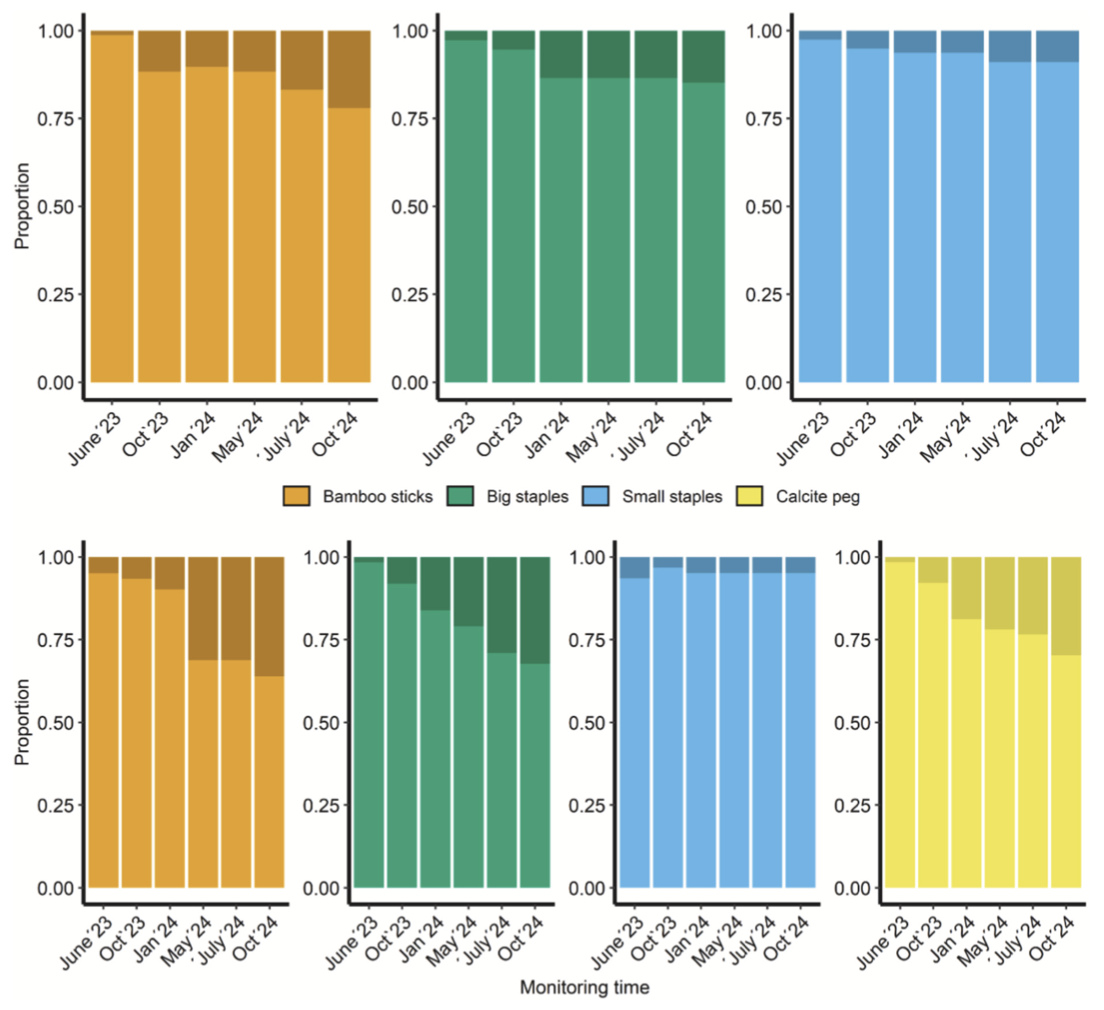
Abstract: Seagrass ecosystems face threats from multiple human-derived stressors that are causing the loss of these important habitats worldwide. Active restoration using innovative, cost-effective techniques, particularly with uprooted fragments that avoid damage to donor meadows, offers potential for recovery. However, non-ecological factors such as cost, logistics or supply are rarely considered but are essential for decision-making and implementation. This two-year study evaluates the feasibility and effectiveness of four anchoring techniques for securing uprooted Posidonia oceanica fragments to the substrate, integrating ecological success with feasibility to identify optimal methodologies. Experiments were conducted in two bays in Mallorca characterized by historical P. oceanica presence. Big staples, small staples, bamboo sticks and calcite pegs, were tested to fix fragments with plagiotropic rhizomes. Across sites, small staples and bamboo sticks supported high establishment success (94 %) while having a low carbon footprint, and ease of use. These methods effectively utilized smaller fragments, which are more commonly available, making them practical for large-scale projects. Although larger fragments may develop more new shoots, their limited availability restricts widespread application. As expected, shoot survival declined, a common patter observed early in P. oceanica restoration process, indicating that a two-year period is insufficient to fully assess long-term restoration success. Consistent performance across sites indicates broad applicability of these techniques in Mediterranean shallow, sheltered areas. Non-ecological indicators also highlight the socio-environmental benefits of bamboo sticks and small staples, making them well-suited for sustainable restoration. These findings underscore the need for a balanced, integrated approach that aligns ecological outcomes with efficiency metrics.
2025

Abstract: Silicon is a major driver of global primary productivity and CO2 sequestration, and is a beneficial element for the growth and environmental stress mitigation of many terrestrial and aquatic plants. However, only a few studies have examined the occurrence of silicon in seagrasses, and its function within seagrass ecosystems and the role of seagrasses in silicon cycling remain largely unexplored. This study uses for the first time two methods, the wet-alkaline digestion and the hydrofluoric acid digestion, to quantify silicon content in seagrass leaves using the species Zostera marina and elaborates on the potential role of silicon in seagrass biogeochemistry and ecology, as well as the role of seagrass ecosystems as a silicon reservoir. The results revealed that seagrass leaves contained 0.26% silicon:dry-weight, which is accumulated in two forms of silica: a labile form digested with the alkaline method and a resistant form digested only with acid digestion. These findings support chemical digestions for silicon quantification in seagrass leaves and provide new insights into the impact of seagrasses on the marine silicon cycle. Labile silica will be recycled upon leaf degradation, benefiting siliceous organisms, while refractory silica will contribute to the ecosystem’s buried silica stock and coupled carbon sequestration. In the Bay of Brest (France), the seagrass silicon reservoir was estimated at 0.18 ± 0.07 g Si m⁻2, similar to that of benthic diatoms, underscoring the potential role of seagrasses in silicon biogeochemistry in the land–ocean continuum, where they might act as a buffer for silicon transport to the ocean.

Abstract: This paper describes an advanced methodology to monitor and assess, in temporal series, meadows of the seagrass Posidonia oceanica. The process includes, the following steps: (a) exploring marine regions of certain biological interest with Autonomous Underwater Vehicles equipped with cameras looking downwards, (b) taking images continuously during missions of preprogrammed trajectories, (c) processing the images off-line to build colour photomosaics, (d) segmenting seagrass from the background in every image using a pretrained Neural Network, (e) computing the same photomosaics but using the segmented images, and (f) computing automatically the bottom coverage of the seagrass counting the proportion of pixels labelled positively. This procedure avoids the involvement of divers, allows increasing depth, extension and duration of missions and offers 2D maps of the whole inspected areas in a single view, which allows us to get more accurate coverage measurements than those obtained with traditional techniques. Experiments have been performed with datasets collected in areas of the Balearic Islands colonized with P. oceanica seagrass and subject to low and high touristic and anchoring pressure during high season, repeating the same transects in consecutive years in order to obtain interannual results. Data obtained with this methodology permit a direct biological qualitative, quantitative and temporal analysis and interpretation, such as the percentage of temporal decline of seagrass coverage in some of the surveyed areas and the annual increase of the meadows extension in others.
2024
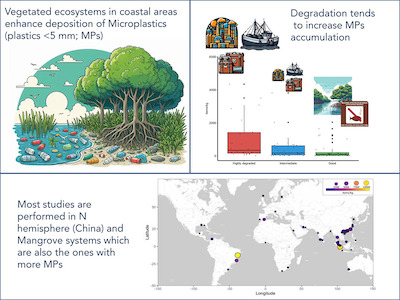
Abstract: Microplastic (plastics < 5 mm; MP) contamination in the marine environment has gained global attention due to its continuous accumulation and serious threats to ecosystems. This review evaluates patterns of MP accumu- lation in seagrasses, mangroves, and saltmarshes to provide an integrated view of MP pollution. Since 2011, studies have examined the sources, distribution, characterization, and fate of MPs in these habitats. We found an unequal geographic distribution with most studies conducted in the Northern Hemisphere and in mangroves, which have the highest MP concentrations compared to saltmarshes and seagrass beds, particularly near urban centers and fishing zones. Almost 40 % of the outcomes of our meta-analysis show a higher MP accumulation in vegetated than unvegetated sites. Also, degraded and highly-degraded sites exhibited higher amounts of MPs than less-degraded areas. In addition, secondary MPs are the dominant form, with less dense polymers (poly- ethylene, polystyrene, and polypropylene) being more abundant and blue, black, and transparent the most common colors. Methodological differences in reporting units, sampling depths, and extraction methods reduce study comparability and increase variability. This review provides a comprehensive understanding of MP research in coastal ecosystems, revealing critical knowledge gaps affecting MP distribution, such as vegetation density, diversity, and hydrodynamics, and emphasizes the need for standardized methodologies for accurate comparisons.
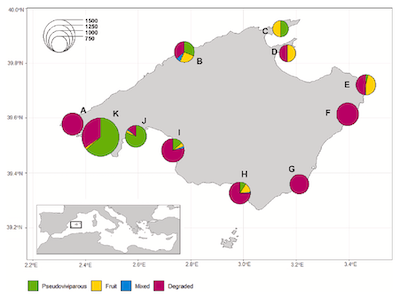
Abstract: Seagrasses are marine flowering plants that create critical coastal ecosystems and are threatened by warming. Clonal expansion is generally the dominant strategy for meadow recovery, while sexual reproduction strongly differs among species (e.g., monoecious and diecious species, some creating seed banks, viviparous seedlings). In 2022, the Western Mediterranean underwent unprecedented warming, and, associated with it, we observed flowering (100 %) across 11 Posidonia oceanica meadows in Mallorca, Balearic Islands. Furthermore, 64 % of the sites also exhibited pseudovivipary, an extremely rare phenomenon in angiosperms whereby plantlets replace sexual reproductive structures, producing clones of the maternal plant. Our results support the notion that P. oceanica flowering and pseudovivipary (genetically confirmed) are triggered by warming, never before being pseudovivipary reported across multiple sites in a marine plant. Considering the negative impacts that warming can have on seagrasses, existence of widespread pseudovivipary is a critical aspect to consider for understanding mechanisms of resilience in seagrasses.
2023

Abstract: Since seagrasses are efficient sinks for marine organic carbon, there is growing interest in incorporating seagrass protection and restoration into climate mitigation schemes, that is, offering credit for accumulated carbon to offset carbon dioxide emissions. However, patterns and drivers of organic carbon storage by seagrasses are not well resolved, especially at scales relevant to management decisions. Here, we quantified geographic variation in stand- ing stocks of sedimentary organic carbon (Mg Corg ha-1) associated with seagrasses along the northern Florida Gulf Coast using field surveys and sediment cores. We measured plant biomass, organic carbon, and sediment composi- tion in each core. Using a multivariate modeling approach, we evaluated the relative importance of ecological, physical, oceanographic, and seascape drivers, developing the first spatially explicit predictions of seagrass- associated carbon stocks for this region. Applying model predictions to confirmed seagrass beds and potential recovery areas, we also estimated the carbon storage value of potential seagrass conservation and restoration as the resulting stock enhancement value per hectare of seagrass (Δ Mg Corg ha-1). We found that organic carbon stored by seagrass sediments varied considerably across this region, with stocks significantly increasing with seagrass cover, proximity to oyster reefs, and distance from river outlets, highlighting potential synergies for coordinated management. We also found that current seagrass beds could offer nearly double the carbon storage value of poten- tial recovery areas, emphasizing the importance of conservation as well as restoration. Our results have important implications for management, restoration, and understanding biogeographic patterns of seagrass ecosystem services.
2022

Abstract: Seagrasses worldwide provide key habitats for fish assemblages. Biogeographical disparities in ocean climate conditions and seasonal regimes are well-known drivers of the spatial and temporal variation in seagrass structure, with potential effects on associated fish assemblages. Whether taxonomically disparate fish assemblages support a similar range of ecological functions remains poorly tested in seagrass ecosystems. In this study, we examined variation in the abundance, diversity (from a taxonomic and functional perspective), and assemblage structure of fish community inhabiting nine meadows of the seagrass Cymodocea nodosa across three regions in the Mediterranean (Mallorca and Alicante) and the adjacent Atlantic (Gran Canaria), and identified which attributes typifying the structure of meadows, and large-scale variability in ocean climate, contributed most to explaining such ecological variation. Despite a similar total number of species between Mallorca and Gran Canaria, the latter region had more taxonomically and functionally diverse fish assemblages relative to the western Mediterranean regions, which translated into differences in multivariate assemblage structure. While variation in the abundance of the most conspicuous fish species was largely explained by variation in seagrass structural descriptors, most variation in diversity was accounted for by a descriptor of ocean climate (mean seasonal SST), operating at regional scales. Variation in fish assemblage structure was, to a lesser extent, also explained by local variability in seagrass structure. Beyond climatic drivers, our results suggest that lower temporal variability in the canopy structure of C. nodosa meadows in Gran Canaria provides a more consistent source of food and protection for associated fish assemblages, which likely enhances the more abundant and diverse fish assemblages there.
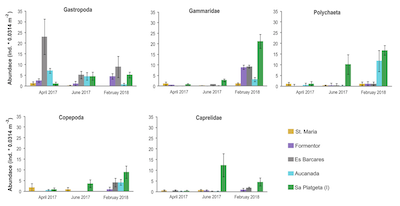
Abstract: The introduction and successful expansion of tropical species into temperate systems is being exacerbated by climate change, and it is particularly important to identify the impacts that those species may have, especially when habitat-forming species are involved. Seagrass meadows are key shallow coastal habitats that provide critical ecosystem services worldwide, and they are threatened by the arrival of non-native macroalgae. Here, we examined the effects of Halimeda incrassata, a tropical alga that has recently colonized the Mediterranean Sea, on epifaunal assemblages associated with Cymodocea nodosa seagrass meadows of Mallorca Island (Western Mediterranean Sea). This invasive macroalga is an ecological engineer and thus has a high potential of modifying native habitats. A seagrass meadow colonized by H. incrassata exhibited important changes on associated epifaunal assemblages, with an increase in abundance and diversity, particularly driven by higher abundances of Gammaridae, Polychaeta, Copepoda and Caprellidae. Given the key ecological contribution of epifauna to food webs, these alterations will likely have important implications for overall food web structure and ecosystem functioning of native ecosystems.

Abstract: Monitoring is a crucial tool for measuring the progress and success of environmental policies and management programs. While many studies have evaluated the effectiveness of biodiversity sampling methods, few have compared their efficiency, which is crucial given the funding constraints present in all conservation efforts. In this study we demonstrate how existing analytical tools can be applied to i) assess the relationship between sampling effort and resulting confidence in biodiversity metrics, and ii) compare the efficiency of different methods for monitoring biodiversity. We tested this methodology on data from marine fish surveys, including: roving surveys within permanent areas, randomly placed belt transects, and randomly placed transects conducted by citizen scientists using a reduced species list. We constructed efficiency curves describing how increasing effort spent on each method reduced uncertainty in biodiversity estimates and the associated ability to detect change in diversity. All programs produced comparable measurements of species diversity for all metrics despite substantial differences in the species being surveyed by each method. The uncertainty of diversity estimations fell faster and reached a lower level for the roving diver method. Strikingly, the transect method conducted by citizen scientists performed almost identically to the more taxonomically resolved transect method conducted by professional scientists, suggesting that sampling strategies that recorded only a subset of species could still be effective, as long as the excluded species were chosen strategically. The methodology described here can guide decisions about how to measure biodiversity and optimize the resources available for monitoring, ultimately improving management outcomes.

Abstract: Differences in phenolic composition across different ontogenic stages can be crucial in determining the interaction outcomes between plants and their surrounding biotic environment. In seagrasses, specific phenolic compounds have rarely been analyzed and remain unexplored in ontogenic stages other than non-reproductive adults. Furthermore, it is generally accepted that plants would prioritize defense (e.g., through increased phenolic content) on tissues or stages that are critical for plant fitness but how this affects nutritional quality or plant resources has been scarcely explored. We analyzed how phenolic composition, N and C content and carbohydrate resources varied among different life stages (i.e. old and young leaves of reproductive and non-reproductive plants, and leaves of seedlings) in the seagrass Posidonia oceanica. We identified five phenolic compounds, whose structures were established as hydroxycinnamate esters of tartaric acid. Also, our results show that in all examined ontogenic stages phenolic compounds have the same qualitative composition but inflorescences exhibit higher contents than vegetative tissues. We did not find a reduction in stored resources in reproductive plants, pointing to some kind of compensatory mechanism in the production or storage of resources. In contrast, seedlings seemed to have less phenolic compounds than reproductive plants, perhaps due to limited resources available to allocate to phenolic production. Our results demonstrate how different ontogenic stages change their investment in specialized phenolic compounds prioritizing different functions according to the needs and limitations of that stage.
2021

Abstract: This study documents the first validation of the suitability of the most common parameters and protocols used in marine ecophysiology to characterize photosynthesis by means of chlorophyll a fluorescence tools. We demonstrate that the effective yield of PSII (∆F/F m’) is significantly underestimated when using short inductions times (≤1min) following the rapid light curve protocol (RLC). The consequent electron transport rates (ETR) underestimations are species-specific and highly variable with irradiance and the photoacclimatory condition of the sample. Our analysis also questions the use of relative descriptors (relETR), as they not only overestimate photosynthesis, but overlook one of the fundamental components of the photosynthetic response: light absorption regulation. Absorptance determinations were fundamental to characterize the ETR response of lowpigmented seagrass leaves, and also uncovered relevant differences between two coral species, and the accclimatory response of a cultured dinoflagellate to temperature. ETR and oxygen evolution determinations (GPS) showed close correlations for all organisms tested with the expected slope of 4e- per O2 molecule evolved, when correct photosynthesis inductions and light absorption determinations were applied. However, ETR curves cannot be equated to conventional P vs E curves, and caution is needed when using ETR to characterize photosynthesis rates above photosynthesis saturation (Ek). This validation strongly supports the utility of fluorescence tools, underlining the need to correct two decades of propagation of erroneous concepts, protocols and parameters in marine ecophysiology. We aim also to emphasize the importance of optical descriptions for understanding photosynthesis, and for interpreting fluorescence measurements. In combination with conventional GPS approaches, optical characterizations open an extraordinary opportunity to determine two central parameters of photosynthesis performance: the quantum yield (φmax) and minimum quantum requirements (1/ φmax) of the process. The combination of both approaches, strengths immensely the possibilities of chlorophyll a fluorescence tools to characterize marine photosynthesis biodiversity

Abstract: Aim: Seagrass beds are declining globally and are increasingly vulnerable to sea level rise (SLR), which could have consequences for the rich biodiversity they support. Spatial variation in the role of seagrass beds in enhancing biodiversity is poorly resolved, limiting our ability to set priorities for conservation and restoration. We aimed to model the biodiversity enhancement value of seagrass beds. Location: Florida Gulf Coast, USA. Methods: We used generalized additive mixed models (GAMMs) to describe the distribution, total cover and species composition of seagrass beds and to estimate their effects on spatial patterns of faunal species richness under three scenarios. Specifically, we: (a) quantified the biodiversity enhancement value of current seagrass beds, (b) inferred the biodiversity value of potential restoration areas and (c) projected potential changes in the distribution and biodiversity enhancement value of seagrass beds due to SLR using low (+0.50 m) and high (+1.0 m) SLR forecasts for 2100. Results: Current seagrass beds supported 43%–64% more species than unvegetated habitats, even when accounting for spatial variability in predicted faunal richness due to other environmental, seascape, temporal and geographic factors. Seagrass restoration in potential habitats would also increase biodiversity in the near-term (i.e., 43%–45% above unvegetated levels). However, model projections indicate that SLR could result in significant losses of current seagrass beds and potential restoration areas, causing contracted distributions and lower seagrass cover. Overall, these changes could result in significant reductions in the enhancement value provided by seagrasses. Although, there could also be many suitable locations for seagrasses by 2100, with some having either comparable or potentially increased enhancement value. Main conclusions: : Our findings highlight the importance of considering spatial variation in biodiversity benefits when planning for seagrass conservation and restoration and when managing the impacts of SLR.
2020

Abstract: Aim: Studies on latitudinal patterns in plant defence have traditionally overlooked the potential effect that resource availability may have in shaping plant defence. Likewise, latitudinal patterns of tolerance traits have rarely been studied, yet they can be a critical component of plant defence. Therefore, the aim of our study was to examine latitudinal variation in the production of tolerance and resistance traits against her- bivory along a latitudinal range and a natural gradient of resource availability from upwelling conditions. Location: Canada, North America and Mexico. Time period: Summer months of 2015. Major taxa used: The seagrass Zostera marina. Methods: We conducted experiments simulating macroherbivore (e.g., bird, fish) dam- age on the seagrass Z. marina at 10 sites across the Eastern Pacific coast (Canada– Mexico) and Quebec and analysed several traits related to resistance and tolerance strategies against herbivory. In addition, we examined the effects of potential sea- grass changes in defence strategies by performing a series of feeding experiments with mesoherbivores in a subset of sites. Results: We found that eelgrass resistance defences did not follow a linear latitudinal pattern but rather followed a bell-shaped curve which correlated with bottom-up control. In sites with higher nutrient availability, plants allocated resources to tol- erance strategies and had lower resistance traits. Furthermore, seagrasses did not respond linearly to increased herbivory pressure; while they tolerated moderate lev- els of herbivory, they underwent a significant reduction in tolerance and resistance under high herbivory levels, which also made them more susceptible to consumers in feeding experiments. Main conclusions: Our results highlight the importance that nutrient availability has in shaping latitudinal patterns of plant defence against herbivory and show how these defences may not respond linearly to increased herbivory pressure in seagrasses.

Abstract: Seagrasses are key habitat-forming species of coastal areas. While previous research has demonstrated considerable small-scale variation in seagrass abundance and structure, studies teasing apart local from large-scale variation are scarce. We determined how different biogeographic scenarios, under varying environmental and genetic variation, explained variation in the abundance and structure (morphology and biomass allocation), epiphytes and sexual reproduction intensity of the seagrass Cymodocea nodosa. Regional and local-scale variation, including their temporal variability, contributed to differentially explain variation in seagrass attributes. Structural, in particular morphological, attributes of the seagrass leaf canopy, most evidenced regional seasonal variation. Allocation to belowground tissues was, however, mainly driven by local-scale variation. High seed densities were observed in meadows of large genetic diversity, indicative of sexual success, which likely resulted from the different evolutionary histories undergone by the seagrass at each region. Our results highlight that phenotypic plasticity to local and regional environments need to be considered to better manage and preserve seagrass meadows.

Abstract: Coastal and marine ecosystems characterized by foundation species, such as seagrass beds, coral reefs, salt marshes, oyster reefs, and mangrove forests, are rich in biodiversity and support a range of ecosystem services including coastal protection, food provisioning, water filtration, carbon sequestration, recreational opportunities, cultural value, among others. These ecosystems have experienced degradation and a net loss of total area in regions around the world due to a host of anthropogenic stressors, resulting in declines in the associated ecosystem services they provide. Because of the extensive degradation in many locations, increasing attention has turned to ecosystem restoration of these marine habitats. Restoration techniques for marine and coastal ecosystems are generally more expensive when compared to terrestrial ecosystems, highlighting the importance of carefully selecting locations that will provide the largest return on investment, not only for the probability and magnitude of restoration success, but also for ecosystem service outcomes. However, site selection and spatial planning for marine ecosystem restoration receive relatively little attention in the scientific literature, suggesting a need to better study how spatial planning tools could be incorporated into restoration practice. To the degree that site selection has been formally evaluated in the literature, the criteria have tended to focus more on environmental conditions beneficial for the restored habitat, and less on ecosystem service outcomes once the habitat is restored, which may vary considerably from site to site, or with more complex landscape dynamics and spatial patterns of connectivity. Here we 1) review recent (2015-2019) scientific peer-reviewed literature for several marine ecosystems (seagrass beds, salt marshes, and mangrove forests) to investigate how commonly site selection or spatial planning principles are applied or investigated in scholarly research about marine ecosystem restoration at different spatial scales, 2) provide a conceptual overview of the rationale for applying spatial planning principles to marine ecosystem restoration, and 3) highlight promising analytical approaches from the marine spatial planning and conservation planning literatures that could help improve restoration outcomes. We argue that strategic site selection and spatial planning for marine ecosystem restoration, particularly applied at larger spatial scales and accounting for ecosystem service outcomes, can help support more effective restoration.
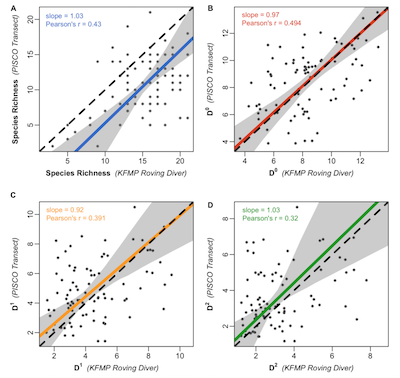
Abstract: Fish abundance and diversity are core measurements taken by many nearshore marine monitoring projects. The most common approaches for counting fish include belt transects and timed counts by roving divers, each with its own limitations. Here we evaluate a fish counting method developed by the Channel Islands National Park’s Kelp Forest Monitoring Program (KFMP), in which roving observers make fish counts that are standardized both by the time taken (30 min) and the area sampled (2000 m2 21 ). This method is potentially very useful because it combines an advantage of simple timed counts – the ability to rapidly sample a large area – with the potential to calculate area-specific density of fish, not just their relative abundance. However, the method has not been comprehensively evaluated and it is uncertain whether fish can effectively be counted in such a large target area within the allotted time. Fortunately, many sites surveyed with this method are also sampled with a more standard fish counting approach of belt transects, both by the KFMP and by the Partnership for Interdisciplinary Studies of Coastal Oceans (PISCO). Here we compare estimates of fish density obtained through the area-standardized roving diver method and belt transect methods. In paired samples we find substantial and species-specific differences in densities estimated by each method. Considering all fish taxa together we find that roving divers are likely under-sampling the target area. Despite considerable species-level variation, the different methods produce similar estimates of average diversity and find similar regional and temporal patterns in fish abundance, demonstrating that they can successfully be used in parallel even if the datasets cannot be easily combined. These analyses can guide the interpretation of roving diver data for basic research and management decisions.
2019
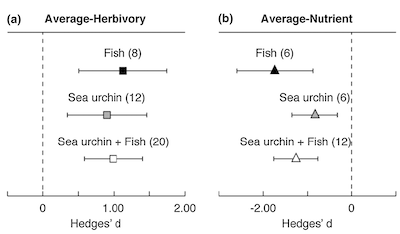
Abstract: Numerous hypotheses have been posited to explain the observed variation in plant defense strategies against herbivory. Under resource-rich environments, plants are predicted to increase their tolerance (limiting resource model; LRM) and, while the resource availability hypothesis (RAH) predicts a decrease in constitutive resistance in plant species growing in resource-rich environments, at the intraspecific level, plants are predicted to follow an opposite pattern (intraspecific RAH). Furthermore, the effect of multiple factors in modulating plant defense strategies has been scarcely explored and is more difficult to predict. Our aim was to understand how plant defense traits respond to herbivory, resource availability and their interactions, and to assess the effects on plant palatability. To this end, we performed an in situ factorial experiment at two sites simulating three herbivory levels and two nutrient availability conditions with the seagrass Posidonia oceanica. Additionally, we performed a series of feeding experiments with its two main herbivores. While plants decreased their constitutive resistance under nutrient fertilization (contrary to intraspecific RAH but in accordance to the RAH), and did not increase allocation to tolerance (likely due to resource limitation, LRM), simulated herbivory induced resistance traits. However, we found no interactive effects of nutrient fertilization and herbivory simulation on plant defense. Both herbivores responded similarly to changes in plant palatability, strongly preferring nutrient-enriched plants and non-clipped plants. This work highlights the need to better understand the drivers of plant defense intraspecific variability in response to resources, particularly in habitat-forming species where changes in plant traits and abundance will cascade onto associated species.
2017

Abstract: Persistent organic pollutants (POPs) reach Antarctica through atmospheric transport, oceanic currents, and to minor extent, by migratory animals. The Southern Ocean is a net sink for many POPs, with a key contribution of the settling fluxes of POPs bound to organic matter (biological pump). However, little is known about POP transfer through the food web in the Southern Ocean and Antarctic waters, where krill is an important ecological node. In this study, we assessed the occurrence of polychlorinated dibenzo-p-dioxins and furans (PCDD/Fs), polybrominated diphenyl ethers (PBDEs), and polychlorinated biphenyls (PCBs) in Antarctic krill (Euphausia superba) from the Bellingshausen, South Scotia and Weddell Seas around the Antarctic Peninsula. The concentrations of PCDD/Fs, PBDEs and PCBs in krill showed a large variability and the average were higher (generally within a factor 3) than those previously reported for eastern Antarctica. This result highlights regional differences related to atmospheric transport and deposition, and also probable regional sources due to human activities. Bioaccumulation and biomagnification factors for PCBs in krill were estimated using previously reported phytoplankton and seawater concentrations for this region. These suggested a near water-krill equilibrium for PCBs, which was not observed for water-phytoplankton partitioning. The estimated removal settling fluxes of PCBs due to the biological pump were several orders of magnitude higher than the estimated fluxes of PCBs transferred from phytoplankton to krill.
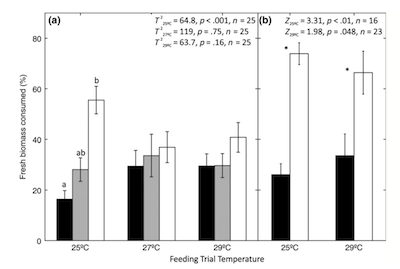
Abstract: Increases in seawater temperature are expected to have negative consequences for marine organisms. Beyond individual effects, species-specific differences in thermal tolerance are predicted to modify species interactions and increase the strength of top-down effects, particularly in plant-herbivore interactions. Shifts in trophic interactions will be especially important when affecting habitat-forming species such as seagrasses, as the consequences on their abundance will cascade throughout the food web. Seagrasses are a major component of coastal ecosystems offering important ecosystem services, but are threatened by multiple anthropogenic stressors, including warming. The mechanistic understanding of seagrass responses to warming at multiple scales of organization remains largely unexplored, especially in early-life stages such as seedlings. Yet, these early-life stages are critical for seagrass expansion processes and adaptation to climate change. In this study, we determined the effects of a 3 month experimental exposure to present and predicted mean summer SST of the Mediterranean Sea (25°C, 27°C, and 29°C) on the photophysiology, size, and ecology (i.e., plant-herbivore interactions) of seedlings of the seagrass Posidonia oceanica. Warming resulted in increased mortality, leaf necrosis, and respiration as well as lower carbohydrate reserves in the seed, the main storage organ in seed- lings. Aboveground biomass and root growth were also limited with warming, which could hamper seedling establishment success. Furthermore, warming increased the susceptibility to consumption by grazers, likely due to lower leaf fiber content and thickness. Our results indicate that warming will negatively affect seagrass seedlings through multiple direct and indirect pathways: increased stress, reduced establishment potential, lower storage of carbohydrate reserves, and increased susceptibly to consumption. This work provides a significant step forward in understanding the major mechanisms that will drive the capacity of seagrass seedlings to adapt and survive to warming, highlighting the potential additive effects that herbivory will have on ultimately determining seedling success.
2016
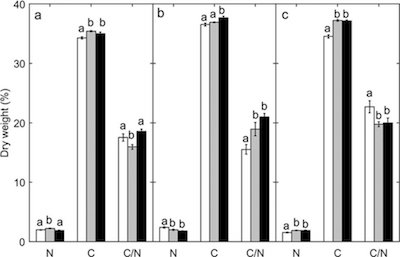
Abstract: Under future increased CO2 concentrations, seagrasses are predicted to perform better as a result of increased photosynthesis, but the eects in carbon balance and growth are unclear and remain unexplored for early life stages such as seedlings, which allow plant dispersal and provide the potential for adaptation under changing environmental conditions. Furthermore, the outcome of the concomitant biochemical changes in plant-herbivore interactions has been poorly studied, yet may have important implications in plant communities. In this study we determined the eects of experimental exposure to current and future predicted CO2 concentrations on the physiology, size and defense strategies against herbivory in the earliest life stage of the Mediterranean seagrass Posidonia oceanica. The photosynthetic performance of seedlings, assessed by uorescence, improved under increased pCO2 conditions after 60 days, although these dierences disappeared after 90 days. Furthermore, these plants exhibited bigger seeds and higher carbon storage in belowground tissues, having thus more resources to tolerate and recover from stressors. Of the several herbivory resistance traits measured, plants under high pCO2 conditions had a lower leaf N content but higher sucrose. These seedlings were preferred by herbivorous sea urchins in feeding trials, which could potentially counteract some of the positive eects observed.
2015
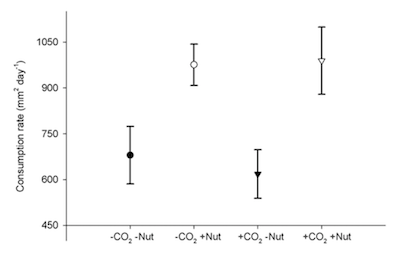
Abstract: Coastal communities are under threat from many and often co-occurring local (e.g., pollution, eutrophication) and global stressors (e.g., climate change), yet understanding the interactive and cumulative impacts of multiple stressors in ecosystem function is far from being accomplished. Ecological redundancy may be key for ecosystem resilience, but there are still many gaps in our understanding of interspecific differences within a functional group, particularly regarding response diversity, that is, whether members of a functional group respond equally or differently to anthropogenic stressors. Herbivores are critical in determining plant community structure and the transfer of energy up the food web. Human disturbances may alter the ecological role of herbivory by modifying the defense strategies of plants and thus the feeding patterns and performance of herbivores. We conducted a suite of experiments to examine the independent and interactive effects of anthropogenic (nutrient and CO2 additions) and natural (simulated herbivory) disturbances on a seagrass and its interaction with two common generalist consumers to understand how multiple disturbances can impact both a foundation species and a key ecological function (herbivory) and to assess the potential existence of response diversity to anthropogenic and natural changes in these systems. While all three disturbances modified seagrass defense traits, there were contrasting responses of herbivores to such plant changes. Both CO2 and nutrient additions influenced herbivore feeding behavior, yet while sea urchins preferred nutrient-enriched seagrass tissue (regardless of other experimental treatments), isopods were deterred by these same plant tissues. In contrast, carbon enrichment deterred sea urchins and attracted isopods, while simulated herbivory only influenced isopod feeding choice. These contrasting responses of herbivores to disturbance-induced changes in seagrass help to better understand the ecological functioning of seagrass ecosystems in the face of human disturbances and may have important implications regarding the resilience and conservation of these threatened ecosystems.
2014
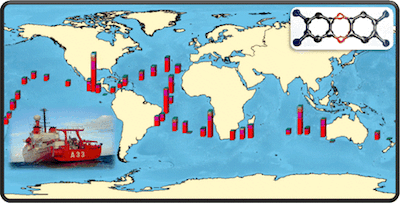
Abstract: The remote oceans are among the most pristine environments in the world, away from sources of anthropogenic persistent organic pollutants (POP), but nevertheless recipients of atmospheric deposition of POPs that have undergone long-range atmospheric transport (LRAT). In this work, the background occurrence of gas and aerosol phase polychlorinated dibenzo-p-dioxins and dibenzofurans (PCDD/Fs) and dioxin like polychlorinated biphenyls (dl-PCB) is evaluated for the first time in the atmosphere of the tropical and subtropical Atlantic, Pacific, and Indian oceans. Thirty-nine air samples were collected during the eight-month Malaspina circumnavigation cruise onboard the R/V Hespérides. The background levels of dioxins and dl-PCBs remained very low and in many cases very close to or below the limit of detection. Expectedly, the levels of PCBs were higher than dioxins, PCB#118 being the most abundant compound. In the particular case of dioxins, octachlorodibenzo-p-dioxin (OCDD) was the most abundant PCDD/F congener. Distribution of dl-PCB is dominated by the gas phase, while for PCDD/F the aerosol phase concentrations were higher, particularly for the more hydrophobic congeners. The Atlantic Ocean presented on average the highest PCDD/F and dl-PCB concentrations, being lower in the southern hemisphere. The assessment of air mass back trajectories show a clear influence of continental source regions, and lower concentrations when the air mass has an oceanic origin. In addition, the samples affected by an oceanic air mass are characterized by a lower contribution of the less chlorinated dioxins in comparison with the furans, consistent with the reported higher reaction rate constants of dibenzo-p-dioxins with OH radicals than those of dibenzofurans. The total dry atmospheric deposition of aerosol-bound ∑PCDD/F and ∑dl-PCB to the global oceans was estimated to be 354 and 896 kg/year, respectively.

Abstract: El Centro de Recursos Fitogenéticos del INIA tiene como principal objetivo contribuir a evitar la pérdida de diversidad genética de las especies cultivadas y silvestres emparentadas, cuyo potencial genético sea susceptible de ser utilizado en agricultura y alimentación. En el presente trabajo se exponen los resultados de la conservación de variedades locales y especies silvestres emparentadas con las cultivadas, conservadas por diferentes instituciones, recolectadas en la Comunidad Autónoma de Andalucía entre los años 1929 y 2009. En los bancos españoles, se conservan un total de 5691 muestras de 10 familias, 48 géneros y 70 especies.

Introduction: Este estudio es fruto de un Convenio de Colaboración (2009-2010) entre el INIA y la empresa Destilerías Marí Mayans C.B., financiado por el Gobern Balear, para la “Catalogación de los recursos genéticos de plantas aromáticas presentes en las Islas Pitiusas, selección y obtención de plantas madre de especies con interés comercial”. El área de prospección del Convenio se corresponde con las islas de Ibiza y Formentera (Islas Baleares, España).